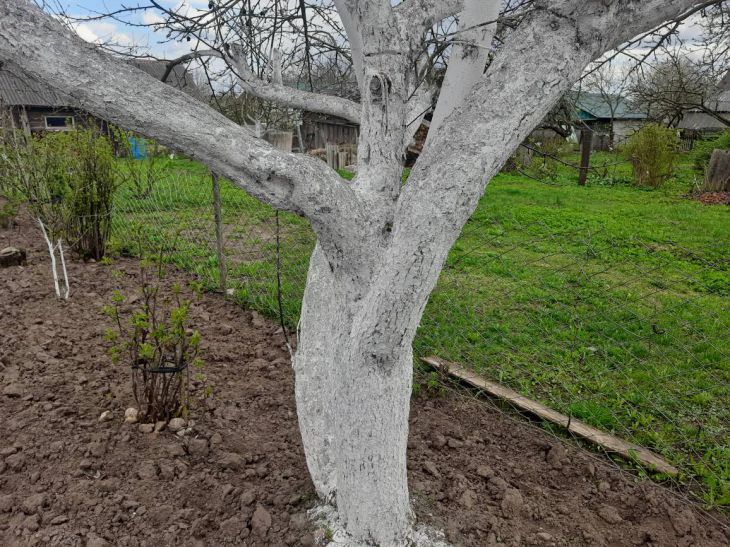The image of an orchard, vegetable garden or even a garden plot is often associated with the white branches of fruit trees.
It is no secret that the treatments that lead to this appearance are aimed not only at improving the aesthetics of the garden, but also at protecting trees from many diseases.
Moreover, contrary to many innovative opinions, whitewashing of trees, although it has a very long tradition, is now being rediscovered and studied in terms of its properties, says Anastasia Kovrizhnykh .
To bleach or not to bleach
Striped fruit trees have their own unique charm that makes us associate them with orchards full of healthy and aromatic fruits.
It is important to remember that whitening of fruit trees is one of the most important operations carried out in an orchard.

The main purpose of this treatment is to protect the trees from damage and then maintain the bark in good general condition.
Over the years, along with changes in the structure of people cultivating garden plots, the approach to whitewashing itself has changed. During this time, many myths and unfair opinions have arisen around this procedure.
Meanwhile, there is nothing scary about bleaching fruit trees, moreover, this simple procedure will allow you to enjoy healthy trees for a long time. However, you must remember to do it correctly and at the right time.
Meanwhile, often even such a simple procedure can be performed incorrectly and therefore not bring the expected positive effect.
Why whitening
A fundamental question that every beginning gardener can ask himself: why is the seemingly insignificant process of whitewashing fruit trees carried out?
After all, it is just a thin layer of white coating, so how can it help a fruit tree grow? The answer to this question is simple. The main purpose of whitewashing trees is to protect their trunks and bark from damage that may occur as a result of temperature changes or minor mechanical defects.
The climate often surprises not only people, but also plants. Sharp temperature changes, especially in early spring and autumn, can lead to icing of fruit trees.
As a result of the heating of plants, their internal development and thus a slight weakening of the external tissues, a situation may arise that will lead to damage to the tree with a sudden drop in temperature. The main symptoms of this condition will be vertical cracks in the trunk and gangrenous wounds.
Such situations can be observed mainly in January and February. Often cloudless skies result in sunlight heating up tree branches, which are then exposed to extremely cold air at night.
Such temperature fluctuations pose a mortal threat to sensitive tree tissues. The occurrence of damage inside the tree, in its soft tissues, can manifest itself primarily in the browning of cells, which will be visible on the cross-section of young shoots.
All these threats can be avoided with a simple procedure: whitewashing tree branches. However, you must remember to do it at the right time and in the right way.
What, when and how to whiten
Young fruit trees are particularly susceptible to damage from sudden temperature fluctuations, especially if they have been recently planted.
In addition to whitewashing the trunks, other measures can be used to protect them, such as embankments at the base of the embankments, installation of special protection against rodents and, in the case of particularly sensitive plants, covering the tree crowns with special covers. Contrary to popular belief, whitewashing should not be done in the first days of spring. This period is definitely too late.
All the endangered shrubs have either already suffered or managed to survive. In any case, whitewashing in early spring does not make much sense.
According to the recommendations of experienced gardeners, trees should be whitewashed no later than the first half of January. The optimal period is the second half of December. However, it is necessary to remember that if the white layer is washed off by spring rains, it is necessary to repeat this procedure so that it remains on the branch until the first days of March.
Whitening is intended to protect plants from sudden temperature changes. This is achieved by reflecting some of the sunlight through the white layer of lime. Thanks to this, the bark does not heat up excessively and, therefore, is not damaged by temperature fluctuations. Therefore, whitewashing trees in March or April will not bring the expected effect. Therefore, it is necessary to learn the rule that trees are whitewashed during the winter itself, and not after it ends.
The agent used to whiten trees is lime. However, it is important to remember that this is not pure lime. To whiten trees, it is necessary to prepare the so-called lime milk. This is a special form of lime solution. To do this, it is necessary to dissolve lime in water in proportions of 2 kg per 10 liters. To this, a little clay or cowhide should be added. This is a method that allows the white layer to remain on the tree bark longer. Effectively protects against rain washing.
The mixture prepared in this way can be used to apply it to the tree. Use a brush for this purpose. It is worth remembering that it is advisable to paint the tree a little higher on the south side, which will better protect it from excessive heating.
For people who do not want to make a mixture for bleaching trees themselves, you can buy a ready-made product.
For this purpose, you should purchase lime for whitewashing trees, ready to use after opening. It has increased adhesion, which allows you to use the lime more effectively and keep it on the tree trunk longer.
When whitening fruit trees, remember that it is also worth protecting the bushes, which can be much more sensitive to sudden temperature changes. However, it is important to remember that properly carried out whitewashing occurs from the base of the tree to the first branch. Thinner branches should also be limed.
It is also worth dispelling the myth that whitewashing trees kills pest larvae and fungal spores that are in the tree bark. This is not true for the simple reason that lime does not have such properties.
Properly protected fruit trees are not only a matter of aesthetics, but, above all, the opportunity to use healthy and fruit-bearing plants that will be the pride of the gardener.
It is also worth remembering that in the case of larger gardens, protecting trees from sudden temperature changes is simply a necessity to protect the harvest. It is also worth remembering that whitewashing trees is not a labor-intensive task, but brings great benefits in the form of healthy plants and fruitful vegetation.
Previously we talked about what plants can be planted between trees in the garden .









